Mary Anne Yarde's Blog: The Coffee Pot Book Club , page 121
September 27, 2019
#BookReview — Dragons in the Clouds by David Blair #mIddlegrade #HistoricalFantasy #Dragons @daveblr77

Dragons in the CloudsBy David Blair

“Dragons in the Clouds’’ is a epic adventure that takes place during a time period when Dragons were alive and freely roamed the land. The people during this time were getting eaten by a vicious species of Dragon. The ruling King finally orders the total annihilation of all living dragons. A powerful wizard, named Merlinus, who is a friend to the king, does not agree with the Kings order, for Merlinus knows all Dragons are not what they seem. So he does what he must to protect a family of Dragons that he had befriended. And to protect his Dragon friends, Melinus performs the spell of weightlessness and tells the Dragons to fly up and to hide in the cover of the Clouds. An unforeseen ability of the Dragons weightlessness spell is that a Dragons fire now looks like that of lightning and their roar is like that of thunder. Melinus tells the Dragons to live within the clouds and to only come down at night to eat. An apprentice to the wizard who has grandeur of his own has a plan for Dragons that he has hidden deep within a mountain cavern. Now enters a widowed mother, her young boy, who had also befriended a dragon, though a very young one. They suddenly find themselves caught between the Kings order and a battle that has begun between two species of Dragons. A battle that would determine control of the skies above the Kingdom of Albian. This Apprentice’s plan has consequences that may bring the Kingdom and perhaps the very world we live in today to an devastating end.

“Merlinus might be hiding dragons...”
On the orders of King Arturus, all dragons are to be killed on sight. There have been too many deaths, too many good men devoured by these loathsome beasts. It is time to put an end to the dragons' unchecked reign of terror.
For the powerful sorcerer, Merlinus, Arthurus’ decree is both troublesome and disturbing. Not all dragons, kill. Not all are loathsome. But the King is set upon driving the dragons to extinction and this Merlinus cannot allow. However, to go against the king and the will of the people is a monumental risk. If it is ever discovered that he is hiding dragons, then the consequences will be severe.
Unbeknown to Merlinus, he has an enemy. An enemy who will do anything to discredit the renowned wizard.
Can Merlinus save the dragons in time? And who is this enemy that would destroy everything that Merlinus has worked so hard to achieve?
From a dark and dangerous night in the Albion Forest to the dragons last stand high up in the sky above Merlinus’ castle, Dragons in the Clouds by David Blair is the unforgettable story about one man’s fight to save a species from annihilation and the unbreakable friendship between a young boy and his dragon.
With its easy prose style and a wonderfully compelling narrative, Dragons in the Clouds is a real treat for children of middle grade reading age. The story is compelling, without being overcomplicated, and there is enough action to keep even the most reluctant reader entertained.
Set within the backdrop of Arthurian legends, Dragons in the Clouds is a thoroughly enchanting story and perfect for children to not only read alone, but it also works as a great bedtime story. I thought the relationship between David, and his best friend, Rago the dragon, was beautiful in its simplicity and enjoyable in the telling. David has more reasons than anyone to hate the dragons, but like Merlinus, he understands that not all dragons are the same. David will defend Rago, no matter what that may cost him. David is a young hero that the reader can really get behind, and his relationship with Rago helps drive this story forward.
I thought the characterisation of Merlinus was terrific. He is everything a wizard should be. He is intelligent, cunning, and above everything else, he is someone who will take a stand against injustice even in the face of considerable opposition. His desire to help the dragons is marred only by the fear that the dragons will be discovered.
I thoroughly enjoyed this book. It had everything an excellent middle-grade book should have. Younger readers of Cressida Cowell’s How to Train Your Dragon series will be utterly enchanted by David Blair’s Dragon in the Clouds.
I Highly Recommend.
Review by Mary Anne Yarde.The Coffee Pot Book Club.
Pick up your copy ofDragons in the CloudsAmazon UK • Amazon US
David Blair
 I am the creator and writer of the original story, ''Dragons in the Clouds'' My most favorite and influential writer would be Rod Sterling, of the fame television show ''The Twilight Zone''. Also Charles Dickens, ''A Christmas Carol'' to this day has a place in my heart. I was captivated watching that show. All my work has a paranormal feel too it. I recently worked as a production supervisor for EnterAktion Studios. I started my story telling at the young age of 14. A student film called ''Destination Destiny''. I am so grateful to have this opportunity.
I am the creator and writer of the original story, ''Dragons in the Clouds'' My most favorite and influential writer would be Rod Sterling, of the fame television show ''The Twilight Zone''. Also Charles Dickens, ''A Christmas Carol'' to this day has a place in my heart. I was captivated watching that show. All my work has a paranormal feel too it. I recently worked as a production supervisor for EnterAktion Studios. I started my story telling at the young age of 14. A student film called ''Destination Destiny''. I am so grateful to have this opportunity.Connect with David: Website • Twitter • Goodreads.
Published on September 27, 2019 21:00
#BookReview — Antonius: Son of Rome by Brook Allen #AncientRome #HistoricalFiction @1BrookAllen
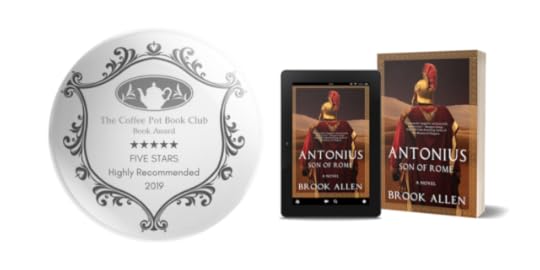 Antonius: Son of RomeBy Brook Allen
Antonius: Son of RomeBy Brook Allen
For over two-thousand years, Marcus Antonius—Marc Antony—has been one of history’s most controversial men. His story was buried with him and written by his enemies. Now his entire saga is revealed in a compelling trilogy by Brook Allen.
After young Marcus Antonius’s father dies in disgrace, he yearns to restore his family’s honor during the final days of Rome’s dying Republic. Marcus is rugged, handsome, and owns abundant military talent, but upon entering manhood, he falls prey to the excesses of a violent society. His whoring, gambling, and drinking eventually reap dire consequences. Through a series of personal tragedies, Marcus must come into his own through blood, blades, and death. Once he finally earns a military commission, he faces an uphill battle to earn the respect and admiration of soldiers, proconsuls, and kings. Desperate to redeem his name and carve a legacy for himself, he refuses to let warring rebels, scheming politicians, or even an alluring young Egyptian princess.

"Well, someday he'd prove himself.He'd command legions.He'd be Rome's greatest soldier..."
But not yet. First, Marcus Antonius has to grow up.
However, this is not a good time to be a child. The Republic is dying, and Spartacus is leading his fellow slaves to revolt against their Roman masters. Worse still, Marcus Antonius is now the head of the household. However, he is not old enough. He is not ready for such a responsibility.
Marcus Antonius' father's death brought nothing but scandal and disgrace. His mother is no longer invited into society. If it were not for her cousin, Gaius Julius Caesar, then Marcus Antonius would have found himself adrift.
Under Caesar, Marcus Antonius could grow to be the kind of man he longs to be. Alas, affairs of state and war drag Caesar away from the impressionable child. And as scandal rocks the family for a second time, Marcus Antonius becomes the very thing he wanted to avoid...
From the acid smoke of a funeral pyre to the splendour of Alexandria, Antonius: Son of Rome by Brook Allen is the story of the early years of the life of Marcus Antonius.
I have read many wonderful historical fiction books that depict the glory and the splendour of Ancient Rome. In these stories, I have witnessed the political intrigue in the Senate and the Assemblies. I have marched alongside the Roman Army and observed terrible battles — not all ending in victory. In these books, I have also experienced the poverty of the plebs and the slaves. I have walked with soldiers, generals, even Caesar. But never have I walked with Mark Anthony. As a child, I can remember watching Joseph L. Mankiewicz's Cleopatra and falling somewhat in love with the whole idea of Mark Anthony. As a teenager and one who so happened to adore Shakespeare, I met him again. But since then, I have not had the pleasure. Until now. Antonius: Son of Rome is the book that I did not realise I had been waiting for.
As I read the last sentence of Antonius: Son of Rome, as I noted the final full stop, as I closed the book, I was for one truly terrifying moment in the life of an Editorial Book Reviewer, utterly speechless. Words that usually come so easily for me suddenly became somewhat harder. Where do I even begin? What could I say that would convey just how incredible Antonius: Son of Rome is? I could talk about the easy prose style, and how reading this book was effortless, it needed nothing from me but the commitment to keep reading — you do not need a comprehensive knowledge of this period in history to understand what is going on, the writing speaks for itself. Allen, like any tour guide worth one's salt, will take good care of you, she will show you a world that, up until now, you have only glimpsed on the screen or in your imagination. I could talk about the dialogue, which is rich and vibrant and bold and above everything else so incredibly successful. But even that does not even begin to describe how great this book is. I could talk about the story, and how it appalled, impressed and fascinated in equal measures. And yet, not even that could sum up the beauty, the majesty of this book. Perhaps I could spend some time talking about the historical accuracy in this novel — how Allen has a historian's eye but a novelist's heart. To write with such precision, with such attention to detail, not only made me as a reader rejoice at discovering I was in the hands of a master, but it also made this book shamelessly compelling and impossible to put down. I could talk about all of that, but it is the star of the show, the portrayal of the protagonist that irrevocably and irreversibly closed the deal for me on this book.
Marcus Antonius (Mark Anthony) — general, politician, a loyal supporter of Julius Caesar, an enemy of Octavian and husband to Cleopatra. We all know the story. Well, I thought I did. Allen starts at the beginning. We meet Marcus Antonius when he is a very young, impressionable eleven-year-old boy, and oh, how I adored him. Allen has presented us with this desperately grief-ridden child who is trying so hard to be the man of the house — the strong one in the family. My heart broke for him as he struggled to come to terms with his father's death, and along with that, he suffers the disgrace that his father also brought upon their heads silently and without comment. At such a young age, Marcus Antonius had so much responsibility placed upon his shoulders, and in this book he does not act like the politician he would become — he is very much a child and a lost one at that. Not much is known of Marcus Antonius' early life, but much can be surmised, and I thought Allen portrayed this time in Marcus Antonius life with such care and diligence that I can only applaud her — wonderfully written.
But the death of his father, as history will tell us, was not the only terrible event to mar Marcus Antonius' young life. The execution of his stepfather Publius Cornelius Lentulus Sura was also a bitter blow. This book had me in tears on more than one occasion, but the death of Lentutlus had me reaching for the Kleenex and sobbing so hard I had to close the book for a moment. What happens then to Marcus Antonius is really not that surprising. I thought Allen did well recreating this time in Marcus Antonius life with the resources she had available. Kudos, Ms Allen.
Allen has portrayed Marcus Antonius as a man who thinks deeply but also a man who loves deeply. She has also presented us with a man who, despite his somewhat capricious beginnings, is very moral, and very honourable. He is at all times, apart from when dealing with money lenders, a man of his word. Marcus Antonius is a man that men look up to and other envy. As he matures and begins to find his way, Allen lets us have these little glimpses of the man he is destined to be. When he finally gets his first commission, Marcus Antonius finds the place where he not only excels but is supposed to be. Marcus Antonius came into his own, and it was glorious to read and wonderful to envisage.
As I have said before, you don't need to know anything at all about Marcus Antonius to enjoy this book. I cannot praise this novel enough. It really is a book in a million. Never has a book screamed to be made into the next big Netflix television series as Antonius: Son of Rome does.
If you read only one historical fiction book this year, then please, please, let it be this one — a brilliant, brilliant story. I wish I had written it. I, for one, cannot wait to find out what happens next — book two cannot come soon enough.
I Highly Recommend.
Review by Mary Anne Yarde.The Coffee Pot Book Club.
Pick up your copy ofAntonius: Son of RomeAmazon UK • Amazon US
Brook Allen
 Brook Allen is a Music Educator in a rural community near Roanoke, VA. Aside from her regular classes, she teaches two ensembles, a Chorus and Recorder Consort. Born in Salt Lake City, UT, Brook was raised in Omaha, Nebraska and has lived all over the U.S., from the Pacific Northwest, all the way down to Florida. She graduated with a B.A. in Music Education and has a M. A. in Liberal Studies, with an emphasis on Roman History. Brook is happily married and has two energetic Labrador Retrievers. Voraciously active, she cycles, hikes, and loves to travel.Connect with Brook: Website • Twitter • Facebook.
Brook Allen is a Music Educator in a rural community near Roanoke, VA. Aside from her regular classes, she teaches two ensembles, a Chorus and Recorder Consort. Born in Salt Lake City, UT, Brook was raised in Omaha, Nebraska and has lived all over the U.S., from the Pacific Northwest, all the way down to Florida. She graduated with a B.A. in Music Education and has a M. A. in Liberal Studies, with an emphasis on Roman History. Brook is happily married and has two energetic Labrador Retrievers. Voraciously active, she cycles, hikes, and loves to travel.Connect with Brook: Website • Twitter • Facebook.
Published on September 27, 2019 20:00
#BookReview — Gift of the Gods: Silver and Gold, Volume 2 by Thomas J. Berry #AncientGreece #HistoricalFiction @TBerryAuthor
Published on September 27, 2019 19:00
September 26, 2019
Join me in conversation with #HistoricalFiction author, Vivienne Brereton #Tudors @VivienneBreret1
A conversation with Historical Fiction author, Vivienne Brereton

Please give a warm Coffee Pot welcome to historical fiction author, Vivienne Brereton. Vivienne’s debut novel — A Phoenix Rising (The House of the Red Duke,#1) is fabulous. I Highly Recommend you all check it out!
I am always curious as to what inspired authors to write their books. What was your inspiration behind A Phoenix Rising?
 I have been an ardent fan of the Tudors since I was a small child and so the choice of time and subject was a natural follow-on from that. I also have a great love of Cornwall, Scotland (from a Scottish grandmother) and France, so all these things played a part.
I have been an ardent fan of the Tudors since I was a small child and so the choice of time and subject was a natural follow-on from that. I also have a great love of Cornwall, Scotland (from a Scottish grandmother) and France, so all these things played a part. My interest in the Howard family probably began with a fascination of Katherine Howard and her tragic story. Further reading of ‘A Tudor Tragedy’ by Lacey Baldwin Smith cemented this. I’ve read several different versions of her life. Poor Katherine. She didn’t really stand a chance: hardly more than a child in the crossfire of the cruel harsh world of Tudor politics.
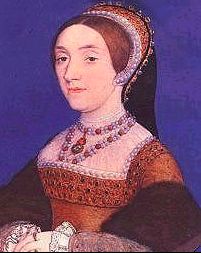 Katherine Howard: Portrait miniature by Hans Holbein the Younger.
Katherine Howard: Portrait miniature by Hans Holbein the Younger.Little by little, I began to get a picture of the Howard dynasty, and particularly of Thomas Howard, the head of the House of Howard and the central figure in my novel. Reading a biography of his life by Melvin Tucker and Robert Hutchinson’s excellent ‘House of Treason’ opened the door wide for an infinite number of possibilities. Discovering George Goodwin’s ‘Fatal Rivalry’ was a turning point and moved the action northwards to include the court of the incomparable James Stuart in Scotland. And so ‘The House of the Red Duke’ was born.
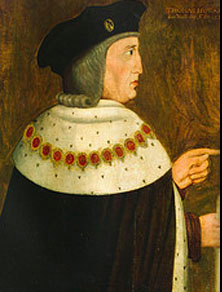 Thomas Howard, 2nd Duke of Norfolk.
Thomas Howard, 2nd Duke of Norfolk.The Howard family certainly played a very pivotal role in the days of the Tudors. What was it like researching this fascinating period of history?
I loved the research part, especially as it was totally different from when I was a history student at uni, under time and subject constraints. I had never visited the British library before which was a joy and a revelation. Of course, the Tudor period was an era I already knew well so the research part was more like the icing on the cake. I dealt with it as an exploration of all six senses and set out accordingly.
I visited art galleries, castles, manors, battlefields, both in England and France. Touched the fabric in costume museums. Cooked Tudor food myself to taste the flavour of the period (using my family as guinea pigs, depending on the dish). Continued to watch all the Tudor programmes and movies and re-watched old favourites like ‘Anne of a Thousand Days.’ I loved Jonathan Rhys Myers and Natalie Dormer as Henry and Anne in ‘The Tudors’. Capturing the glamour, the passion and ultimately fated tragic pairing. They totally nailed it. I love all perfume so deciding which scents to include was a pleasure. When they were younger, my three sons were dragged along to jousts which they loved and Tudor music events which they didn’t. One of them was being a bit naughty and got lost accidentally on purpose in the Hampton Court Maze. Not an experience for the faint-hearted, slightly claustrophobic parent.
I love researching too, it is one of my favourite parts about being a historical fiction author, and I hate to admit it, I once got lost in Hampton Court’s Maze as well — unfortunately, it was only two years ago! Mazes and me… No, not a good idea. But I digress... The Tudor era is really popular, and there are many books out there depicting it. What makes your book different?
There are many brilliant books about the Tudor period. The three things I think that set A Phoenix Rising apart are:
· It’s not just about England but equally Scotland, France, and Habsburg Burgundy, not forgetting Cornwall, ‘the backdoor of rebellion’. The Valois Kings, Louis X11and Francois 1, plus the Stuart, James IV, are not the most well-known of kings which is a great pity. I hope I’ve done them justice.
· A Phoenix Rising incorporates fact and fiction, told from several points of view. Some of it is deliberately in the first person while I felt other characters related better in the third person.
· There are a few yummy authentic Tudor recipes to try.
As I have read your book, I know it is brilliant, and I loved the recipes! Before you go, could you tell my readers what you are currently working on?
I am currently working on the sequel, called ‘The Lizard lurking in the Grass’.
I have a strong attachment to Cornwall (with a Cornish husband) and have chosen a short extract, featuring two of the main characters: Tristan (half-Cornish and half-French) and Cecily (half-Cornish and half-mermaid, according to her father). They have escaped from a tedious sermon in the chapel of Saint Michael’s Mount and have decided to go to a May Day Fair in Marazion, on the other side of the causeway. It is told from Cecily’s point of view.
“I could tell Tristan was as eager as me to go to the fair from the way we almost flew down the side of the Mount, along the well-trod Pilgrim’s Way, past the ancient well, once home to a giant named Cormoran, tricked into falling into its murky depths by little Jack, a local boy. Cormoran had been wreaking havoc in the villages across from the Mount, stealing livestock, and even babies and young children to appease his appetite. Jack came up with the idea of digging a pit during the hours of darkness. As the dawn broke and the sun appeared in the sky, the little boy called out to the giant who stumbled out of his cave into the blinding sunshine and fell headlong into the trap Jack had laid for him.
With all my efforts centred on reaching the causeway below, I didn’t stop to show Tristan the heart of the giant, embedded in the cobbles of the winding path. In no time at all, we reached the causeway. What exhilaration I felt both to have escaped, and to be running barefoot with Tristan towards the mainland, my own and his laughter lost on the wind. In one hand, I held my red leather shoes, and in the other, the skirts of my matching kirtle of the best Flemish cloth, held up high in a most scandalous fashion. The mingled tang of salt and seaweed was as heady as any jasmine scent from the Far East, worn by a lady in her boudoir to seduce her sweetheart.
‘You can be Perkin Warbeck, and I’ll be Catherine Gordon!’ I yelled back as I sprinted ahead of my cousin, as sure-footed as a goat that has committed every stone to memory. ‘You can’t catch me!’ I panted into the wind.”
I would like to finish off with a recipe from the May Day Fair: gingerbread as you’ve never tasted it before. Delicious.
Gyngerbrede
250g clear honey200g fresh white breadcrumbs1teaspoon ground cinnamon1 teaspoon ground ginger1 long pepper or 1 teaspoon ground black pepper 3 strands of saffron To decorate: Fresh box leaves, such as marjoram or bay leaves or basil. Whole cloves to keep the leaves in place.
1) Slowly bring the honey to the boil in a saucepan. 2) Turn the heat down very low and add the spices. Cook for a couple of minutes and then gradually add the breadcrumbs, stirring all the time. 3) The mixture should be very stiff, if not, add a few more breadcrumbs. 4) Turn out onto a board and roll it flat until about an inch thick.5) Line a shallow rectangular tin with greased paper and lay the mixture flat inside. Press it down with your fingers.6) Place it in the fridge for two hours.7) Turn the pan upside down and place the gingerbread on a plate.8) Cut it up to your own taste. Squares, hearts, diamonds. Roll some into balls if you so wish.9) Decorate the top by taking a whole clove and pressing it into two leaves of your choice. 10) It stores well in a tin.Two fifteenth century cookbooks 1425-1450.
Thank you so much for dropping by today and for the recipe. I will be sure to try it out!
A Phoenix Rising(The House of the Red Duke, #1)By Vivienne Brereton

“If I have anything to do with it, we Howards will live forever.”
Thomas Howard Charismatic head of one of the most powerful Houses in Tudor England. An indomitable old man approaching eighty: soldier, courtier, politician, a ‘phoenix’ rising from the ashes. After a calamitous period of disgrace, the Howards, renowned for their good looks and charm, are once more riding high at the court of Henry VIII.
Set against the backdrop of the extraordinary 1520 ‘Field of Cloth of Gold’, it is a tale of ambition, love, and intrigue, with Thomas at the centre of this intricate tapestry
Will Thomas’s bold vow be fulfilled? Danger stalks the corridors of the royal courts of Europe. Uneasy lies the head beneath a crown. Every other ruler - a fickle bedfellow…or sworn enemy.
The action takes place in England, Scotland, and France. On either side of the Narrow Sea, four young lives are interwoven, partly unaware of each other, and certainly oblivious to what Dame Fortune has in store for them.
“Nicolas de La Barre laid his lute to one side, hardly bothering to stifle a yawn of boredom. Nevertheless, he couldn’t escape the fact he’d agreed to take on a new wife….”
Explosive family secrets are concealed behind the ancient walls of castles in three lands. But…
“There are no secrets that time does not reveal.”
The Coffee Pot Book Club★★★★★ Highly RecommendedRead the full review HERE!

Giveaway
Vivienne Brereton is giving away one print copy of her fabulous new release
A Phoenix Rising (The House of the Red Duke, #1)

All you need to do is answer this question:
At the Battle of Bosworth, did the Howard family fight on the side of the White Rose of York or the Red Rose of Lancaster?
Giveaway Rules
• Leave your answer in the comments at the bottom of this post.• Giveaway ends at 11:59pm BST on October 2nd.You must be 18 or older to enter.• Giveaway is only open Internationally.•Only one entry per household.• All giveaway entrants agree to be honest and not cheat the systems; any suspect of fraud is decided upon by blog/site owner and the sponsor, and entrants may be disqualified at our discretion.•Winners will be announced in the comments.• Winner has 48 hours to claim prize or new winner is chosen.
Pick up your copy ofA Phoenix RisingAmazon UK • Amazon US
Vivienne Brereton
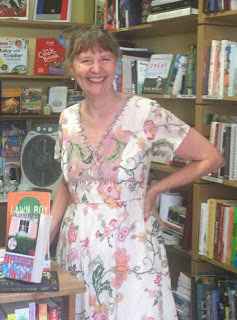 I’ve always loved the Tudor period, from a very early age, have a degree in medieval history. I’ve lived in six different countries in my life and soaked up the history in each one. I now live in France which made writing about three different countries and cultures easier for me. I’ve always worked with words wherever I’ve lived: teaching, editing, writing.
I’ve always loved the Tudor period, from a very early age, have a degree in medieval history. I’ve lived in six different countries in my life and soaked up the history in each one. I now live in France which made writing about three different countries and cultures easier for me. I’ve always worked with words wherever I’ve lived: teaching, editing, writing. I’m married with three sons so plenty of scope for Nicolas and Tristan! Anne Boleyn was the only character I found slightly elusive. All the others were so vivid, I had no problem getting into their heads. Of the kings, James was my favourite and after all my reading I hope I did him justice. All were brilliant men. Renaissance men, so cultured. What would they make of ours today? Harry could easily pass for Henry’s naughty little brother. Not sure Charles would make the grade.
Connect with Vivienne: Website • Blog • Goodreads.
Published on September 26, 2019 20:00
September 25, 2019
Join author, M J Porter, as she talks about what inspired her to write Historical Fiction #amwriting #HistoricalFiction @coloursofunison
An Author's InspirationBy M J Porter
I don’t really know when I became a fan of historical fiction but I can take a good guess at who, and what, was to blame.
William Shakespeare and Macbeth.
 Macbeth and Banquo encounter the witches for the first time.
Macbeth and Banquo encounter the witches for the first time.When I was at school, we didn’t get ‘bogged’ down with grammar and spellings, oh no, we studied stories, and plays and words, and also the ‘motivation’ behind the use of those stories and those words. And it was Macbeth that first opened my eyes to the world of historical fiction.
Yes, Macbeth is a blood thirsty play, and it might be cursed, but more importantly, it’s based on Holinshed’s Chronicle of England, Scotland and Ireland.
Macbeth is nothing better than the first work of historical fiction that I truly read, and understood to be as such. And what a delight it was.
I remember less the story of Macbeth as presented by Shakespeare (aside from the three witches – “when shall we three meet again?” “well I can do next Wednesday,’ (thank you Terry Pratchett for that addition), than working out ‘fact’ from ‘fiction’ in his retelling of the story. And hence, my love of historical fiction was slowly born, and from that, stems my love of telling stories about ‘real’ people and the way that they lived their lives, looking at the wider events taking place, and trying to decide how these might, or might not, have influenced these people.
Shakespeare chose the story of a little known ‘Scottish’ monarch for his historical fiction, my latest subject is the third wife of King Edward the Elder, again someone that few people have heard of, but who’s relative, many years in the future, would have interacted with Macbeth, or rather with Mac Bethad mac Findlaích.
Lady Eadgifu, the Lady of Wessex, lived through a tumultuous time.
Many people, studying Anglo-Saxon England, know of King Alfred (diedAD899), and they know of his grandson, Æthelred II (born c.AD968), known as ‘the unready’. But the intervening period is little known about, and that is a true shame.
Lady Eadgifu, just about singlehandedly fills this gap. Born sometime before c.AD903 (at the latest), her death occurred in c.AD964/6. As such, she probably missed Alfred by up to 4 years, and her grandson, King Æthelred by about the same margin.
But what she did witness was the emergence of ‘England’ and the ‘kingdom of the English’ as we know it. And it was not a smooth process, and it was not always assured, and it was certainly, never, at any point, guaranteed that England would emerge ‘whole’ from the First Viking Age.And more importantly, rather than being one of the kings who ruled during this period, Lady Eadgifu was the king’s wife, the king’s mother, or even the king’s grandmother, during this period. She would have witnessed England as it expanded and contracted, she would have known what went before, and she would have hoped for what would come after her life.
Lady Eadgifu is simply too good a character to allow to lie dormant under the one event that might well be known about from the tenth century – the battle of Brunanburh.So, for those fans of Bernard Cornwell’s ‘Uhtred’ and for those fans of Lady Elfrida at the end of the tenth century, I hope you will enjoy Lady Eadgifu. She was a woman, in a man’s world, and because she was a woman, she survived when men did not.
I hope you enjoy.
KingmakerThe story of Lady Eadgifu, the Lady of WessexBy M J Porter

As England’s first Viking Age grinds to a halt in a war of attrition that will see Jorvik finally added to the kingdom of the English, one woman will witness it all.
Seventeen-year-old Eadgifu knows little about her new husband; he’s old, he only wants to marry her because she’s so wealthy, he already has ten children, and he’s Edward, king of Wessex. He also hopes to claim Mercia as his own.
That he’s the son of King Alfred, the man credited with saving Wessex from the Viking Raiders adds no mystique to him at all.
Many say he’s handsome, but Eadgifu knows they speak of the man twenty years ago. Her mother won’t even allow her to be alone with him before their wedding.
But an old man will not live forever. The mother of his youngest sons can be more powerful than the wife of the king of Wessex, especially in the newly made kingdom of England where king’s lives are short and bloody, and war with the Viking Raiders is never far away.
Lady, wife, queen, mother, king’s mother, grandmother, ally, enemy, amenable and rebellious.
Lost to the mists of time, this is Queen Eadgifu’s story, Kingmaker.
Pick up your copy ofKingmakerAmazon UK • Amazon US
M J Porter
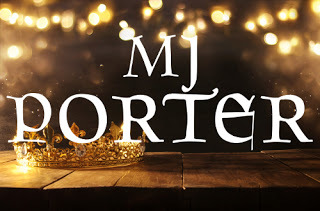 I'm an author of fantasy (Viking age/dragon themed) and historical fiction (Anglo-Saxon, Vikings and the British Isles as a whole before the Norman Conquest), born in the old Mercian kingdom at some point since the end of Anglo-Saxon England. Raised in the shadow of a strange little building and told from a very young age that it housed the bones of long dead Kings of Mercia and that our garden was littered with old pieces of pottery from a long-ago battle, it's little wonder that my curiosity in the Anglo-Saxons ran riot. I can only blame my parents!
I'm an author of fantasy (Viking age/dragon themed) and historical fiction (Anglo-Saxon, Vikings and the British Isles as a whole before the Norman Conquest), born in the old Mercian kingdom at some point since the end of Anglo-Saxon England. Raised in the shadow of a strange little building and told from a very young age that it housed the bones of long dead Kings of Mercia and that our garden was littered with old pieces of pottery from a long-ago battle, it's little wonder that my curiosity in the Anglo-Saxons ran riot. I can only blame my parents!Connect with M J Porter: Website • Twitter • Amazon Author Page.
Published on September 25, 2019 20:00
September 24, 2019
The Story of Germanus by Mary Anne Yarde #Folklore #Legends #Britain
The Story of Germanus
By Mary Anne Yarde
 Germanus, Bishop of Auxerre.
Germanus, Bishop of Auxerre.Britannia's very foundation is built on stories. Over time some of these stories have been forgotten, which I think is a crying shame. If you are a regular reader of this blog, you will know that my particular interest is Arthurian legend, but I wanted to cast my net a little bit wider and have a look at a very intriguing battle that is aptly named...
The Hallelujah Victory
*Britain was, with a few exceptions, under Roman rule from 43ADc. to 410. However, by the end of the 4th Century, The Roman Empire had run into some problems. I am not going to go into what problems they were today, as this would take up several posts, but what I will say is they found themselves in a position where they did not have enough troops to defend Britain from the ever-increasing barbarian attacks.
To cut a very long story short, the Roman's abandoned their posts and withdrew from the island. Briton was alone. She now had to look to herself to defend her borders.
What Briton needed was a saviour. A hero. They found one in Germanus of Auxerre.
Who was Germanus of Auxerre and why did he travel to Britain?
Around 429 a Gaulish Assembly of Bishops met, and they discussed a very concerning matter. They had heard a troubling rumour that Pelagianism was rife in the British clergy and that would never do. They sent Germanus of Auxerre, Bishop of Auxerre, and Lupus, Bishop of Troyes, to pay a visit to these rebellious islanders. When they reached Briton, Germanus and Lupus confronted the British clergy in an open meeting. They were disgusted by what they saw, but with a careful rhetorical argument, Germanus saved the day and steered Briton away from Pelagianism and back onto the correct and righteous path.
But that wasn't all that Germanus did.
Briton had been an occupied country for a long time. They had spent many years under the protection of the Roman Army. But there was no Roman Army in Briton anymore. The Picts and the Scots were not ones to miss an opportunity. They crossed over the Wall, that the Romans' had once so diligently guarded, and invaded. They killed, pillaged and burnt. The Britons were beside themselves. How were they going to defeat such a military might? Rome certainly wasn't going to come to their aid. In desperation, they asked Germanus for help.
 Hadrian's Wall.
Hadrian's Wall.Germanus, ever confident, told the people of Briton if they did exactly as he told them, all would be well. Germanus meant what he said. He not only had God on his side, but he was also a highly educated man. He had studied eloquence and civil law in Rome. Before he entered the Church, he had held very high offices in government. He knew what he was talking about.
Germanus picked his battleground carefully. He said the only way they could beat the barbarians was by having the higher ground. He found the perfect location — it was a remote, mountainous site near a river. He told his small army to climb the mountains and spread out over the three sides of the valley. This they did.
The Picts and Scots confidently rode into the valley. They thought this would be an easy win. They were in for a surprise!
An arrow shot across the sky. This was the signal Germanus' men had been waiting for. Germanus yelled,
"Hallelujah! Hallelujah! Hallelujah!"
His army took up the cry. The sound of their voices echoed off the mountain walls. The Picts and Scots were deafened by a noise of what sounded like thousands of men.
"Hallelujah!" the army of Germanus yelled.
"Hallelujah!" they yelled again.
Fearing that they were about to be slaughtered by the largest army that had ever been assembled, the Picts and Scots dropped their weapons, turned around and fled.
The Britons were victorious. Germanus sent the Barbarians home without one drop of blood being shed. Quite an achievement in anyone’s book!
So, there were have it, The Hallelujah Victory.
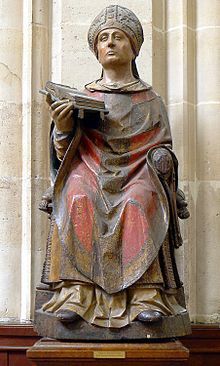 Saint Germain l'Auxerrois statue.
Saint Germain l'Auxerrois statue.The site of the bloodless battle is in a place now named Maes Garmon in Flintshire, North Wales. The name simply means "The Field of Germanus."
Mary Anne Yarde
 Mary Anne Yarde is the multi award-winning author of the International Bestselling Series — The Du Lac Chronicles. Set a generation after the fall of King Arthur, The Du Lac Chronicles takes you on a journey through Dark Age Britain and Brittany, where you will meet new friends and terrifying foes. Based on legends and historical fact, The Du Lac Chronicles is a series not to be missed.
Mary Anne Yarde is the multi award-winning author of the International Bestselling Series — The Du Lac Chronicles. Set a generation after the fall of King Arthur, The Du Lac Chronicles takes you on a journey through Dark Age Britain and Brittany, where you will meet new friends and terrifying foes. Based on legends and historical fact, The Du Lac Chronicles is a series not to be missed.Mary Anne is the founder of The Coffee Pot Book Club. She has been a professional reader since 2016 and in this time Mary Anne has reviewed many books for the big and small publishing houses, as well as books penned by her fellow indie authors. Mary Anne is also an editorial reviewer for The Coffee Pot Book Club. Mary Anne has been a judge for a prestigious Historical Fiction Book Award for the last three years, as well as being a Top Reviewer on Netgalley.
Born in Bath, England, Mary Anne Yarde grew up in the southwest of England, surrounded and influenced by centuries of history and mythology. Glastonbury — the fabled Isle of Avalon — was a mere fifteen-minute drive from her home, and tales of King Arthur and his knights were part of her childhood.
You can contact Mary Anne by email:
author@maryanneyarde.com
If you would prefer to chat on social media, then you can find Mary Anne on Twitter and Facebook.
*Cornwall and what we now call Scotland never succumb to occupation under The Roman Empire.
<!-- /* Font Definitions */ @font-face {font-family:"Cambria Math"; panose-1:2 4 5 3 5 4 6 3 2 4; mso-font-charset:0; mso-generic-font-family:roman; mso-font-pitch:variable; mso-font-signature:-536870145 1107305727 0 0 415 0;} @font-face {font-family:Calibri; panose-1:2 15 5 2 2 2 4 3 2 4; mso-font-charset:0; mso-generic-font-family:swiss; mso-font-pitch:variable; mso-font-signature:-536859905 -1073732485 9 0 511 0;} /* Style Definitions */ p.MsoNormal, li.MsoNormal, div.MsoNormal {mso-style-unhide:no; mso-style-qformat:yes; mso-style-parent:""; margin:0cm; margin-bottom:.0001pt; mso-pagination:widow-orphan; font-size:12.0pt; font-family:"Calibri",sans-serif; mso-ascii-font-family:Calibri; mso-ascii-theme-font:minor-latin; mso-fareast-font-family:Calibri; mso-fareast-theme-font:minor-latin; mso-hansi-font-family:Calibri; mso-hansi-theme-font:minor-latin; mso-bidi-font-family:"Times New Roman"; mso-bidi-theme-font:minor-bidi; mso-fareast-language:EN-US;} .MsoChpDefault {mso-style-type:export-only; mso-default-props:yes; font-family:"Calibri",sans-serif; mso-ascii-font-family:Calibri; mso-ascii-theme-font:minor-latin; mso-fareast-font-family:Calibri; mso-fareast-theme-font:minor-latin; mso-hansi-font-family:Calibri; mso-hansi-theme-font:minor-latin; mso-bidi-font-family:"Times New Roman"; mso-bidi-theme-font:minor-bidi; mso-fareast-language:EN-US;} @page WordSection1 {size:612.0pt 792.0pt; margin:72.0pt 72.0pt 72.0pt 72.0pt; mso-header-margin:36.0pt; mso-footer-margin:36.0pt; mso-paper-source:0;} div.WordSection1 {page:WordSection1;} </style> -->
Published on September 24, 2019 19:30
September 23, 2019
#HistoricalFiction author, Margaret Porter, is talking about what inspired her to write a novel about Hedy Lamarr @MargaretAuthor
An Author’s Inspiration
Beautiful Invention:
A Novel of Hedy Lamarr
By Margaret Porter
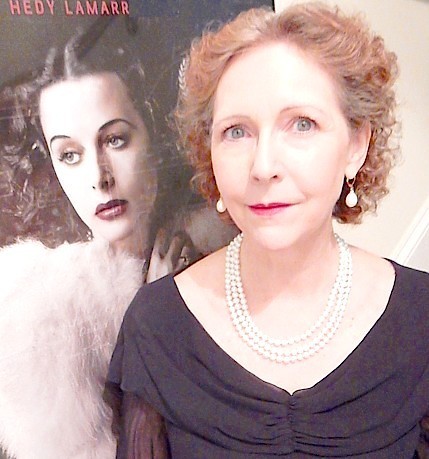
From my teenage years, I was aware of Hedy Lamarr’s existence. My father made no secret of the fact that she was his adolescent movie crush. When he grew up, he married a more attainable brunette beauty—my mother—but he never forgot Hedy. Whenever I paraded before him in an evening gown, or played an ingenue role in a play, his highest praise was, “You look like Hedy Lamarr.” I didn’t, but I appreciated the compliment. I never imagined, back then, that in the future I would know far more about Hedy as a novelist than he ever did as a moviegoer. When I was a graduate student in film studies, I encountered the famous—and in its day, infamous--Czechoslovakian art film Ecstasy, and its place in cinematic history. I don’t remember making the connection between young Hedwig Kiesler, the teenager in a nude swimming scene and a scandalous—for its time—sex scene. I was unaware of the movie’s impact on Hedy the person, or the extent to which it clouded her career, her first marriage, and her reputation in Europe and after she emigrated from Austria to America. Golden Age Hollywood has always fascinated me, but for a long time Hedy Lamarr was but one of many glamorous actresses who were featured in black and white movies.The desire to write about Hedy resulted from various serendipities. Not many years after her death, I conducted internet search, hunting down information on 1930s and 40s film stars—her near contemporaries. I kept hitting articles about her recently publicized technological achievement. I filed this tantalizing fact the in the recesses of my mind—it was quite surprising and unexpected. Not long after, a couple of nonfiction biographies of her were published, and a later came another book focused primarily on her increasingly famous invention, which became the basis of satellite technology for defense and commercial uses, remote control devices, Bluetooth, wifi, mobile phones, and more.Although I was writing biographical fiction about people of 17th and 18th century England, gradually I pondered whether I should look to Hedy Lamarr as the protagonist of a novel. I’ve written several books about performing artists, so that was a part of her appeal. There were challenges—for instance, the time period was well outside my comfort zone. Yet I’d extensively studied cinema history as a graduate student, and after earning my M.A. I continued reading about related subjects just for pleasure. And I’ve always been a fan of old movies.Before long, Hedy had slipped into my brain and entirely co-opted my attention. My research began with the two fine biographies and the book about her invention, and I located numerous other explorations of her life and career. Even so, Beautiful Invention is based mostly on my own primary research. There was so, so much available material to pore over.
 Margaret & a Hedy Lamarr magazine cover.
Margaret & a Hedy Lamarr magazine cover.In the novel that resulted, I reveal a character who is both obscure and well-known, depending on whether a person is a fan of classic cinema from Hollywood’s Golden Age, or perhaps viewed the documentary film Bombshell, or possesses knowledge of female inventors in general or has heard that Hedy was responsible for frequency-hopping and spread-spectrum technology specificallyThis is my 13th work of fiction, and Hedy by far is the most challenging character I’ve ever written. There are multiple reasons, more than I’ll take time to explain. But certain aspects of her life aligned with my own. I was able to draw on my own past—my professional work in theatre and film. Like Hedy, I spent time examining costume sketches and standing like a statue for fittings. I recall the thrill of receiving visitors to my dressing room after a stage performance. I know what it's like to stand on a soundstage, waiting for the producer and director and the technicians to complete their tasks so I can begin mine. Admittedly, I never achieved the degree of fame that Hedy Lamarr did. But I understood her working environment.Beautiful Inventionpresents Hedy Lamarr as an actress, inventor, patriot, and survivor. One of my goals for the book was to uncover and reconstruct truths that were obscured by the MGM publicity machine, or by Hedy herself, and I was determined to refute persistent myths about her. Thus, another significant inspiration for writing Hedy’s fascinating story was to present the complex, intelligent, conflicted woman who was both blessed and cursed with one of the most beautiful faces of all time.

Beautiful Invention: A Novel of Hedy LamarrBy Margaret Porter

Hollywood Beauty. Brilliant inventor. Hedy Kiesler, Austrian actress of Jewish heritage, scandalizes Europe with her nudity in the art film Ecstasy. Her hasty marriage to a wealthy munitions merchant disintegrates as he grows increasingly controlling and possessive. Even worse—he supplies deadly weapons to Hitler’s regime. She flees husband and homeland for Hollywood, where Louis B. Mayer transforms her into Hedy Lamarr, an icon of exotic glamour. Professional success clashes with her personal life as marriage and motherhood compete with the demands of studio and stardom. Roused to action by the atrocities of World War II, Hedy secretly invents a new technology intended for her adopted country’s defense—and unexpectedly changes the world.One of the Top 12 Hollywood Historical Novels recommended by Bustle.com“Captivating . . . Porter’s insightful account of a gifted yet often misunderstood inventor and movie star makes for a winning novel.” ~ Publishers Weekly“Fast, fun, fascinating, enjoyable, intriguing, and recommended.” ~ Historical Novels Review
Pick up your copy ofBeautiful Invention: A Novel of Hedy Lamarr
Amazon UK • Amazon US • Apple iBooks
• Kobo• Barnes and Noble • Waterstones
Margaret Porter
MARGARET PORTER is the award-winning, bestselling author of Beautiful Invention: A Novel of Hedy Lamarr and twelve other historical novels for U.S. and foreign-language publishers. After studying British history in the U.K., she worked professionally in theatre, film, and television. A historian and avid traveler, Margaret returns annually to Great Britain and Europe to research her novels. She lives in New England with her husband and their dogs, dividing her time between an architecturally unique book-filled house in a small city and a waterfront cottage on one of the region’s largest lakes. More information is available at her website, www.margaretporter.com.Connect with Maragret: Twitter • Facebook • Instagram. <!-- /* Font Definitions */ @font-face {font-family:"Cambria Math"; panose-1:2 4 5 3 5 4 6 3 2 4; mso-font-charset:0; mso-generic-font-family:roman; mso-font-pitch:variable; mso-font-signature:-536870145 1107305727 0 0 415 0;} @font-face {font-family:Calibri; panose-1:2 15 5 2 2 2 4 3 2 4; mso-font-charset:0; mso-generic-font-family:swiss; mso-font-pitch:variable; mso-font-signature:-536859905 -1073732485 9 0 511 0;} /* Style Definitions */ p.MsoNormal, li.MsoNormal, div.MsoNormal {mso-style-unhide:no; mso-style-qformat:yes; mso-style-parent:""; margin-top:0cm; margin-right:0cm; margin-bottom:8.0pt; margin-left:0cm; line-height:107%; mso-pagination:widow-orphan; font-size:11.0pt; font-family:"Calibri",sans-serif; mso-ascii-font-family:Calibri; mso-ascii-theme-font:minor-latin; mso-fareast-font-family:Calibri; mso-fareast-theme-font:minor-latin; mso-hansi-font-family:Calibri; mso-hansi-theme-font:minor-latin; mso-bidi-font-family:"Times New Roman"; mso-bidi-theme-font:minor-bidi; mso-ansi-language:EN-US; mso-fareast-language:EN-US;} a:link, span.MsoHyperlink {mso-style-priority:99; color:#0563C1; mso-themecolor:hyperlink; text-decoration:underline; text-underline:single;} a:visited, span.MsoHyperlinkFollowed {mso-style-noshow:yes; mso-style-priority:99; color:#954F72; mso-themecolor:followedhyperlink; text-decoration:underline; text-underline:single;} .MsoChpDefault {mso-style-type:export-only; mso-default-props:yes; font-size:11.0pt; mso-ansi-font-size:11.0pt; mso-bidi-font-size:11.0pt; font-family:"Calibri",sans-serif; mso-ascii-font-family:Calibri; mso-ascii-theme-font:minor-latin; mso-fareast-font-family:Calibri; mso-fareast-theme-font:minor-latin; mso-hansi-font-family:Calibri; mso-hansi-theme-font:minor-latin; mso-bidi-font-family:"Times New Roman"; mso-bidi-theme-font:minor-bidi; mso-ansi-language:EN-US; mso-fareast-language:EN-US;} .MsoPapDefault {mso-style-type:export-only; margin-bottom:8.0pt; line-height:107%;} @page WordSection1 {size:612.0pt 792.0pt; margin:72.0pt 72.0pt 72.0pt 72.0pt; mso-header-margin:36.0pt; mso-footer-margin:36.0pt; mso-paper-source:0;} div.WordSection1 {page:WordSection1;} </style></div><br /><br /><br /><br /><br />
Published on September 23, 2019 20:30
September 22, 2019
An Author’s Inspiration: How to Catch a Wicked Viscount by Amy Rose Bennett #Regency #HistoricalRomance @AmyRoseBennett
An Author’s InspirationHow to Catch a Wicked Viscount By Amy Rose Bennett

Hi Mary Anne, and you so much for having me on Myths, Legends, Books, & Coffee Pots again! Today I’m here to chat about a source of inspiration for my latest release, a Regency romance entitled How to Catch a Wicked Viscount. It’s Book 1 in my brand-new Disreputable Debutantes series.
How to Catch a Wicked Viscount (and the other forthcoming titles in the series) all explore the theme of ‘scandal’ and the resultant aftermath—societal disgrace. I’ve always been fascinated by how the strict rules of etiquette during the Regency era governed the lives of young women. Having a pristine reputation was everything if you hoped to be accepted by polite society and marry well. Just think of the anguish Elizabeth Bennet and her family go through when they learn young Lydia has run off with the roguish Wickham in Jane Austen’s Pride and Prejudice. Indeed, Mr. Darcy goes out of his way to contain the scandal for Elizabeth’s sake—and don’t we adore him for it? The notion that a scandal could destroy a young, single woman’s reputation and thus ruin her chances in the marriage-mart was one I was also keen to visit.
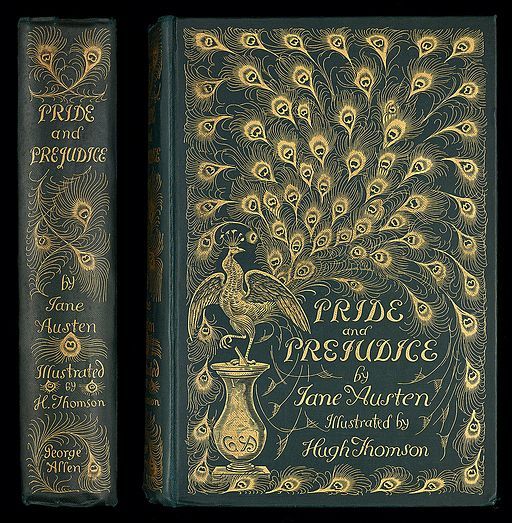 Pride and Prejudice 1894 edition.
Pride and Prejudice 1894 edition.The heroine of How to Catch a Wicked Viscount, Miss Sophie Brightwell—as well as her three friends—face social ruin when they are expelled from a young ladies’ academy for ‘conduct unbecoming’. The free-spirited Lady Charlotte ‘Charlie’ Hastings instigates a late-night ‘dorm party’ so Sophie and the other young women can experience pastimes bachelors are fond of, but women are largely forbidden to take part in: drinking spirits, smoking cigarillos, and learning about the ‘ins and outs’ of sexual congress as depicted in licentious reading material and lewd prints. Charlie reasons that they all need to understand the male of the species before they make their debuts. Of course, our aspiring debutantes are caught red-handed, a monumental scandal ensues, and Society’s doors are firmly closed on them. Even after three years, when Sophie (whose family is sliding into genteel poverty) is afforded a second chance to have a Season courtesy of Charlie and her father the Earl of Westhampton, she and Charlie still bear the label of being ‘disgraced’.
During the Regency era, the ‘bad boys’ of the ton—rakehells—were given rather more leeway by Society and could get away with just about anything as long as their debauched antics weren’t too publicly outrageous. For instance, Lord Byron who was infamous for his sexual escapades and licentious behaviour in general, really only faced public condemnation which drove him from England altogether, when rumours of an incestuous affair with his half-sister could no longer be ignored.
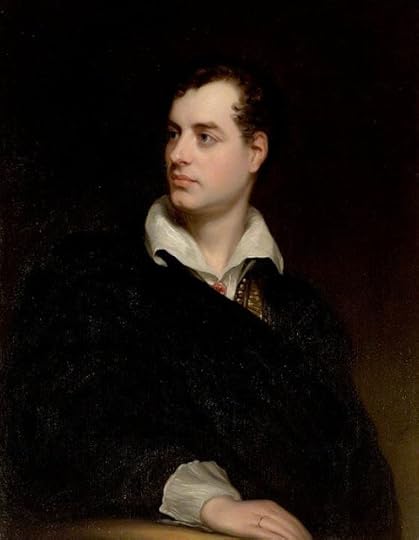 Lord Byron.
Lord Byron.The ‘wicked viscount’ in my book, Nate, Lord Malverne, while definitely a rake—and whose wild exploits appear with alarming regularity in the newspapers—isn’t quite so dissolute as Byron. Nate is the older brother of Sophie Brightwell’s best friend, Charlie—and despite the fact Charlie has warned her that Nate is ‘not the marrying kind’ whatsoever—Sophie has a huge crush on him which she can’t seem to shake. Considering his own notoriety, she hopes he might overlook her besmirched reputation.
Society’s hypocrisy about the consequences of scandal for men versus women is reflected upon by Sophie when she hears about one of Nate’s racier public escapades…
“ It must be lovely to be in a position like Lord Malverne’s. Not only was he rich, handsome, and titled, it seemed he could do whatever he pleased and society didn’t really give a fig. Whereas she would always be watched, pointed at, and judged, rather like a pilloried prisoner, or one in the docks awaiting sentencing. Any misstep off the narrow path of decorum could end her just as effectively as the hangman’s noose. To have the same amount of privilege that circumstance had bestowed upon Lord Malverne would be heady indeed.
To give the reader the impression that the judgmental ‘eyes and the ears’ of the ton are everywhere, the chapters of How to Catch a Wicked Viscount begin with an excerpt of an article from a ‘high society’ newspaper, the Beau Monde Mirror related to the action; although it purports not to be, my fictional publication has the reputation of being little more than a scandal rag.
I had initially imagined the Beau Monde Mirror as a scandal sheet. However, according to the Oxford English Dictionary and Merriam-Webster’s the term ‘scandal sheet’ wasn’t used until 1904. And the Beau Monde Mirror really needed to be more than just a gossip pamphlet. More research on my part was clearly required to come up with the perfect style of ‘scandal rag’ for How to Catch a Wicked Viscount.
In the Regency era, there were certainly a multitude of newspapers available. Author Cheryl Bolen notes in an article for the Beau Monde Chapter of Romance Writers of America, that in 1816, thirty-one national newspapers were published in Britain including fourteen in London. Daily papers included: The Morning Chronicle, Morning Post, The Times, The Morning Herald, The Sun, The Globe, The Star, and The Statesman. The Mirror of the Timeswas a Saturday only publication.

When researching the history of newspapers, magazines, and gossip rags to decide on the nature and an appropriate format for the Beau Monde Mirror, I discovered that newspaper gossip columns began appearing in the early eighteenth century. Author Roger Wilkes, in “Scandal: A Scurrilous History of Gossip,” mentions that in 1704, Daniel Defoe began the first “informal chatty newspaper column” in The Review (Pollock, 2015). Defoe also apparently devised the technique of keeping names secret by only including the gossiped about individual’s initials (Guinness, 2003); my fictional Beau Monde Mirror employs a similar technique.
While many Regency era British newspapers reported on parliamentary proceedings, social issues and other important events, they also pedalled gossip as news. According to Roger Wilkes, reporters would purchase scurrilous stories from loose-lipped servants and ladies and gentlemen willing to expose their friends. The John Bull newspaper which established a reputation for publishing scandalous stories, first appeared in England in 1820. Queen Caroline, the estranged wife of Prinny, was apparently a favourite target of The John Bull’seditor, Theodore Hook (Gaston, 2008).
Regency era magazines popular with women included Le Beau Monde, or Literary and Fashionable Magazine, 1806-1810, and La Belle Assemblée. Laudermilk and Hamlin, the authors of the Regency Companion, write that La Belle Assemblée: "… contained a wealth of information on a wide range of women's concerns. It was a true women's magazine with celebrity anecdotes, instructions of manners, cosmetic advice, and beauty aids. Dress and fashion were covered in delightfully colored fashion plates—the best of which were from 1809 to 1820. Fashion plates were presented with lengthy, written descriptions, and modish gentlewomen pounced on the latest monthly issue… The magazine was filled with advertisements that touted the wonders of various rouges, depilatories, powders, and corsets."Until the 1820s, La Belle Assemblée also apparently published original poetry and fiction, non-fiction articles on politics and science, book and theatre reviews, and serialized novels.

I was also initially drawn to the idea of using Tatler for the title for my fictional publication because of the homophone ‘tattler’ and its gossipy connotation. Indeed, there have been various publications named Tatler over the years. In 1709, Sir Richard Steele—writing under the nom de plume Isaac Bickerstaff—published a literary and society journal of that name. A thrice weekly publication, it contained news of high society balls, charity events, race meetings, shooting parties, fashion and gossip. The Female Tatler appeared in 1709, three months after the original Tatler was published (an unknown female writer using the pen name "Mrs. Crackenthorpe" was apparently the author). Other incarnations of the ‘Tatler’ over time include: the Northern Tatler, the Tatler Reviv’d (eighteenth century publications), and The Tatler: A Daily Journal of Literature and the Stage (1830). And then of course, there’s today’s well-known British high society lifestyle and fashion magazine, Tatler which was first published in 1901.
 Sir Richard Steele.
Sir Richard Steele.
In the end, the inspiration for my newspaper-cum-scandal-rag, the Beau Monde Mirror was an amalgamation of the concept behind the original 1709 Tatler and the modern Tatler, early nineteenth century ‘gossip’ columns and newspapers like The John Bull, and Regency era magazine’s catering for women such as La Belle Assemblée and its rival, Le Beau Monde, or Literary and Fashionable Magazine. The Beau Monde Mirror certainly reports gossip as news in its ‘Society Page’, but there’s are also an ‘Essential Style and Etiquette Guide’ and a literature review section.
Here’s a snippet of the first Beau Monde Mirror scandal-mongering ‘headline’ that appears at the beginning of Chapter One in How to Catch a Wicked Viscount.
Disreputable Debutantes in the making!
A shocking scandal of epic proportions at a certain London school for “Young Ladies of Good Character” shakes the ton.
Does your genteel daughter attend such a den of iniquity? Read on to discover ten things one should consider when choosing a reputable academy...
The Beau Monde Mirror: The Society Page
I hope readers enjoy the gossipy Beau Monde Mirrorexcerpts at the start of each chapter and the ‘scandals’ contained within. I certainly had fun researching and writing How to Catch a Wicked Viscount!
How to Catch a Wicked ViscountBy Amy Rose Bennett
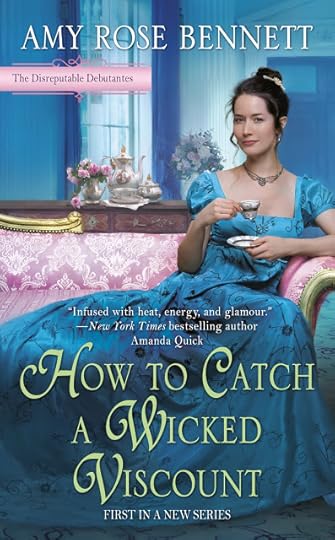
A young lady's tarnished reputation might cost her everything in this first book in the Disreputable Debutantes series.
Shy, bookish Sophie Brightwell is expected to make an advantageous match to improve her family's fortunes. However, Sophie's plans to make a spectacular debut go horribly awry when she and her three closest friends are expelled from a young ladies' academy for unbecoming conduct. Since the ton will be sure to close their doors on these disgraced debutantes, they determine that unconventional means need to be employed in the husband-hunting market. Rakehells—the beau monde's wickedest members—might be the only men willing to overlook a young lady's besmirched reputation.
But how does one catch a rake?
Nate Hastings, the devil-may-care Viscount Malverne, is the older brother of Sophie’s best friend, fellow disgraced debutante Lady Charlotte. When a terribly foxed Nate accidentally compromises Sophie, Charlotte strikes a wicked bargain: in order to avoid a scandal and the parson's mousetrap, Nate must help Sophie snare a husband. But as Nate fulfills his obligation and begins to instruct the lovely Sophie in the art of luring rakes, he soon finds himself battling his own fierce attraction to her.
Pick up your copy of How to Catch a Wicked ViscountAmazon • Barnes and Noble • Kobo•iBooks • Google• Penguin Random House
Amy Rose Bennett
 Amy Rose Bennett is an Australian author who has a passion for penning emotion-packed historical romances. Of course, her strong-willed heroines and rakish heroes always find their happily ever after.
Amy Rose Bennett is an Australian author who has a passion for penning emotion-packed historical romances. Of course, her strong-willed heroines and rakish heroes always find their happily ever after.A former speech pathologist, Amy is happily married to her very own romantic hero and has two lovely, very accomplished adult daughters. When she’s not creating stories, Amy loves to cook up a storm in the kitchen, lose herself in a good book or a witty rom-com, and when she can afford it, travel to all the places she writes about.
Connect with Amy Rose: Website• Facebook• Twitter • BookBub • Pinterest •Amazon
Sources:
Bennet, Bliss. “The Real Regency Scandal Sheets?” Susana’s Parlour. December 21, 2015. https://susanaellisauthor.wordpress.com/tag/regency-scandal-sheets/Bolen, Cheryl. “The Proliferation of Newspapers in Regency England.” The Beau Monde. March 22, 2012. https://thebeaumonde.com/the-proliferation-of-newspapers-in-regency-england/Decker, Cathy. “Le Beau Monde, or Literary and Fashionable Magazine, 1806-1810” Regency Fashion.org. http://regencyfashion.org/bm/beaum.html (accessed August 21, 2019).Decker, Cathy. “John Bell's La Belle Assemblée, or Bell's Court and Fashionable Magazine Addressed Particularly to the Ladies, 1806-1868.” Regency Fashion.org. http://regencyfashion.org/lb.html (accessed August 21, 2019).Gaston, Diane. “Scandal! Gossip! Research.” Risky Regencies. August 25, 2008. http://www.riskyregencies.com/2008/08/25/scandal-gossip-research/Grace, Maria. “Newspapers, Gossip Columns, and Scandal Mongers.” English Historical Fiction Authors. March 12, 2018. https://englishhistoryauthors.blogspot.com/2018/03/newspapers-gossip-columns-and-scandal.html Guinness, Daphne. “Scandal: A Scurrilous History of Gossip 1700-2000.” The Sydney Morning Herald. March 15, 2003. https://www.smh.com.au/entertainment/books/scandal-a-scurrilous-history-of-gossip-1700-2000-20030315-gdgfew.html Laudermilk, Sharon, and Teresa L. Hamlin. The Regency Companion. New York: Garland, 1989Schroeder, Anngela. “Scandal Sheets.” January 18, 2017. A Covent Garden Gilflurt’s Guide to Life. https://www.madamegilflurt.com/2017/01/scandal-sheets.htmlPollock, Michael. “America’s First Gossip Column, and Eating on Subways and Buses.” The New York Times. October 2, 2015. https://www.nytimes.com/2015/10/04/nyregion/americas-first-gossip-column-and-eating-on-subways-and-buses.htmlWikipedia contributors, "La Belle Assemblée," Wikipedia, The Free Encyclopedia, https://en.wikipedia.org/w/index.php?title=La_Belle_Assembl%C3%A9e&oldid=849924298(accessed August 21, 2019).Wikipedia contributors, "Richard Steele," Wikipedia, The Free Encyclopedia, https://en.wikipedia.org/w/index.php?title=Richard_Steele&oldid=900506158 (accessed August 21, 2019).Wikipedia contributors, "Tatler (1709 journal)," Wikipedia, The Free Encyclopedia,https://en.wikipedia.org/w/index.php?title=Tatler_(1709_journal)&oldid=879846930(accessed August 21, 2019).Wilkes, Roger. A Scurrilous History of Gossip. London: Atlantic Books, 2002
Published on September 22, 2019 20:00
September 20, 2019
#BookReview — The Brotherhood of the Black Flag: A Novel of the Golden Age of Piracy by Ian Nathaniel Cohen #HistoricalFiction #Pirates @INCspotlight
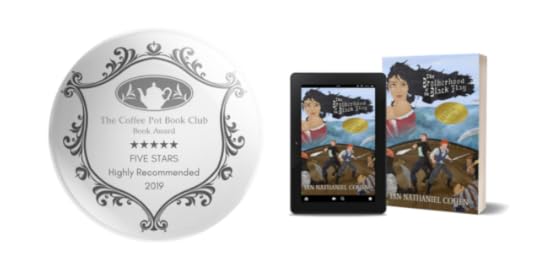 The Brotherhood of the Black FlagA Novel of the Golden Age of PiracyBy Ian Nathaniel Cohen
The Brotherhood of the Black FlagA Novel of the Golden Age of PiracyBy Ian Nathaniel Cohen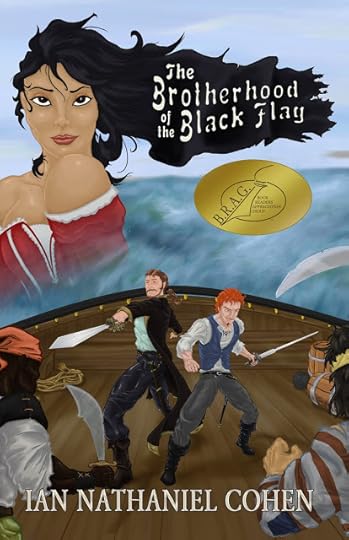
Michael McNamara has one last chance to fight for king and country.
His once-promising career in tatters, McNamara leaves the newly-United Kingdom behind in search of a new life. With no other skills but the sword, he joins forces with a pirate turned pirate hunter determined to rid the Caribbean of the Brotherhood of the Black Flag once and for all.
Eager for the adventure and a worthy cause to fight for, McNamara pits himself against treacherous seas and battle-hardened buccaneers...and uncovers an international conspiracy that threatens thousands of lives.
The Golden Age of Piracy is about to end...but not without one final reckoning.

"Everything you've heard about Captain Reynard is true..."
Michael McNamara should have paid more attention.
But everyone says Stephen Reynard, Captain of The Predator has seen the error of his ways. It seems that the love of a good woman can change even the most unscrupulous of characters. There is also a rumour that this once infamous pirate has made a deal with the English Crown.
It is true that one must set a thief to catch a thief — the same can be said for pirates. Charged with bringing an end, once and for all, to the illegal and barbaric practices of piracy, Reynard wastes no time in hunting down his prey. And although he already has a loyal crew, there is always room for one more.
Having left the British Navy under a cloud of disgrace, and having lost his job as a smallswords instructor, McNamara seeks new opportunities in Jamaica. But never in his wildest of dreams could McNamara have imagined that he would sail under the command of Captain Reynard. Despite what he has heard, McNamara likes this reformed pirate. He respects Reynard. He trusts him. And five hundred pieces of eight is enough to turn any man's head. One voyage with Captain Reynard and McNamara could set up a business of his own. It would be madness to refuse...
From the relative safety of the Salle des Armes in Bath to the High Seas of the Caribbean, The Brotherhood of the Black Flag: A Novel of the Golden Age of Piracy by Ian Nathaniel Cohen is a book rich in heroism, love, hate, retribution, as well as valour in the face of a horrifying evil.
Powerfully imaginative and with a keen eye on the entertaining, Cohen has penned a book that is not only an enthralling epic adventure set during the Golden Age of Piracy but one that is also witty and inspired. I loved everything about this story. The vivacious storytelling and the fast-paced narrative swept me away.
The story is told, for the most part, from the perspective of Michael McNamara. McNamara is a very moral man. He will stand up for injustice, no matter what that costs him. McNamara is also charismatic and extremely amiable. McNamara judges a man by what he sees, and not by reputation, which at times can make him seem incredibly naive. However, McNamara is the kind of character that a reader can really connect with. He is wonderfully portrayed — a true protagonist in this tale of cut-throats and crime.
With a sense of the theatrical, Stephen Reynard is everything a respectable captain should be. He is kind, compassionate, and more importantly reformed. Reynard is a man who is easy to admire, and just as easy to love — he is a classical romantic, a diamond in the rough. With his charismatic personality, it was very easy to see why Catalinina fell in love with him and why McNamara respects him so much. Cohen has presented his readers with this incredible, enigmatic anti-hero. Many times, I found myself chuckling at not only the things Reynard said but also, as one would expect from a great showman, how he said them. I was thoroughly entertained by Reynard's character from start to finish. Reynard is a very complex character who hides behind a mask of good humour and good intention. His character drove this story forward, and it made this book not only swashbucklingly compelling but next to impossible to put down.
Cohen's attention to historical detailing was beautiful to behold. And his adaptation of life on board a former pirate ship and the crew that comes with it was sublime. Very realistic and absolutely effortless to read. Kudos, Mr Cohen.
There is a hint of romance in this book, and of course, there is the all-consuming passion of the High Sea, but what Cohen does not romanticise is the realities of piracy and how truly awful these men were. Accuracy in depicting this era and these men were obviously at the forefront of Cohen's mind while he penned this book. The pirates in The Brotherhood of the Black Flag are cruel, vicious, and unmerciful. They thrive on misery and suffering. They take what isn't theirs, and damn the consequences. This was a ruthless era and a dangerous one. The Brotherhood of the Black Flag does not gloss over the facts. This is what pirates were like, and this is why they were feared.
If you love a good pirate adventure with a huge plot twist, then The Brotherhood of the Black Flag: A Novel of the Golden Age of Piracy is the book you have been looking for.
I Highly Recommend.
Review by Mary Anne Yarde.
The Coffee Pot Book Club.
Pick up your copy ofThe Brotherhood of the Black FlagAmazon UK • Amazon US
Ian Nathaniel Cohen
Ian Nathaniel Cohen is a native of Miami, Florida, where he grew up immersing himself in swashbuckler literature and film. He graduated from the University of Central Florida in 2003 with a BA in Radio/Television Production and a Minor's Certificate in Applied Computer Science. He also received his MA in Asian Studies from Florida International University in 2006, where he teaches the course Asia Through Film as an adjunct lecturer. In 2010, his essay "Heroes & Villains of the East", analyzing the evolving depiction of the Japanese in Chinese and Hong Kong martial arts cinema, was published in FIU's Japan Studies Journal.
He also writes a review blog, the INCspotlight, focusing on classic films, comic books, and video games.
Connect with Ian: Twitter • Goodreads.
Published on September 20, 2019 20:00
September 19, 2019
Join #HistoricalFiction author, John Holt, as he take a look at Fictional Detectives @JohnHoltAuthor
Fictional Detectives
By John Holt
How do you like your detectives? I mean, do you like the tough guy type like Sam Spade, or Mickey Spillane. Handy with their fists, and a gun, and quick with the wise crack. They are tough talking, and hard hitting. Or perhaps you prefer the more methodical type, the ones with the little grey cells, who work on psychology. Nothing and no one can fool Poirot. Nothing gets passed him. It makes you wonder why anyone would even consider committing a crime knowing he was in the same house, or at least close by. But they always do whether it is at a county house called Styles; in Mesopotamia, or on a Nile cruise.
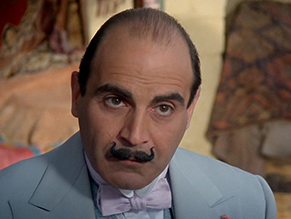 David Suchet as Hercule Poirot in Problem at Sea— Wikipedia.
David Suchet as Hercule Poirot in Problem at Sea— Wikipedia.How about that deceptively quiet and unassuming, Miss Jane Marple? An irritant to some maybe, but she would always outsmart the cleverest policeman, and solve the most complex crime imaginable. And all while she carried on with her knitting. Then there is possibly the greatest detective of them all, Sherlock Holmes. Logic and deduction are his watch words. Give him a few strands from a man’s scarf, and he will not only deduct where the scarf was purchased, and how much it cost, but will also be able to tell that the man was thirty-eight years old, with dark wavy hair, six foot two in height, walks with a limp, and had kippers for breakfast, named William, (the man that is, not the kippers. I don’t know what their names were).
 Holmes and Watson in a Sidney Paget illustration for "The Adventure of Silver Blaze"
Holmes and Watson in a Sidney Paget illustration for "The Adventure of Silver Blaze"How about Inspector Jacques Clouseau? “I suspect everyone, and I suspect no one.” No matter how bumbling he was, or how silly, he still, somehow, “Solv Ed” the crime. Generally by accident admittedly.
Then, of course, there are a whole plethora of television detectives. Who can forget Kojak, and his lollipop, with his catch phrase “Who loves ya baby?” Or Sergeant Joe Friday – “Just the facts ma’am.” Or perhaps Columbo is more to your taste, with his “Just one more thing.” We all know what that meant don’t we? There are a whole collection of them – Magnum; Jessica Fletcher; Rockford starring the late great James Garner; Ironside; Cagney and Lacey; Morse; Starsky and Hutch; to name but a few.
Then, of course, we have Tom Kendall, private detective. He really wanted to be a Private Investigator, but that was judged to be far too long to fit on the office door, so detective it was. Kendall is a down to earth guy, slightly over-weight, far from fit, and suffers with hay fever. Stubborn, who once he had an idea, he would never let go. He is ably assisted by Mollie, his secretary and business partner – their relationship is purely platonic – and first appeared in “The Mackenzie Dossier”, a story of political corruption, blackmail and, of course murder. There then following cases involving a jewel robbery; a worldwide epidemic; fraud; and always a murder or three.
There were six more novels in total.
Kendall latest case, the eighth, “The Art of Murder”, centres on the disappearance of two valuable oil paintings from the Galleria Lafayette. Kendall is employed by the insurance company to recover the paintings. What does Kendall know about art? Precisely nothing. Oh sure he has a nice print in his apartment. Some nice yellow flowers, sunflowers. It cost him $9-99 plus tax in Walmart. The frame was another twenty dollars. He liked it, and that was all that mattered. He wasn’t sure that he was suited to such a case. After all the missing paintings had been valued at three million dollars, each. But a robbery is a robbery is a robbery, whether it is a necklace, or a painting. And there was a pretty good fee on offer. How could he refuse?
It wasn’t long before the case took a turn for the worst, and a body was found. Trevor Lancaster, a respected art collector was found dead. A short while later there is another murder, Ken Bishop, an employee at the Galleria Lafayette.
The Art of Murder By John Holt

Pick up your copy of
The Art of Murder
Amazon
John Holt
 I was born in Bishops Stortford, Hertfordshire, during World War 2. Clearly the world had a lot to contend with at that time, so my coming offered some welcome relief. Whether I had a major influence, or it was pure coincidence, I shall never know, but the war ended shortly after my birth. I have always been a half glass full kind of person, and I’m quite positive in my approach to life. I was brought up on a diet of Rock ‘n’ roll, and only two TV channels. How did we ever manage I wonder? Programmes like Bilko, and Tony Hancock helped I guess, and probably accounts for my sense of humour. As a youngster I wanted to become a doctor, however there was problem, a major problem. I hated the sight of blood, so eventually I became a land surveyor, and spent 24 years working in local government. I then set up in private practice, carrying out property surveys, and preparing architectural drawings. I guess, like a lot of people I had always wanted to write. In fact for several years I used to write articles for a couple of blues magazines (sadly no longer in operation). But I wanted to write a novel.
I was born in Bishops Stortford, Hertfordshire, during World War 2. Clearly the world had a lot to contend with at that time, so my coming offered some welcome relief. Whether I had a major influence, or it was pure coincidence, I shall never know, but the war ended shortly after my birth. I have always been a half glass full kind of person, and I’m quite positive in my approach to life. I was brought up on a diet of Rock ‘n’ roll, and only two TV channels. How did we ever manage I wonder? Programmes like Bilko, and Tony Hancock helped I guess, and probably accounts for my sense of humour. As a youngster I wanted to become a doctor, however there was problem, a major problem. I hated the sight of blood, so eventually I became a land surveyor, and spent 24 years working in local government. I then set up in private practice, carrying out property surveys, and preparing architectural drawings. I guess, like a lot of people I had always wanted to write. In fact for several years I used to write articles for a couple of blues magazines (sadly no longer in operation). But I wanted to write a novel.
Published on September 19, 2019 20:00
The Coffee Pot Book Club
The Coffee Pot Book Club (formally Myths, Legends, Books, and Coffee Pots) was founded in 2015. Our goal was to create a platform that would help Historical Fiction, Historical Romance and Historical
The Coffee Pot Book Club (formally Myths, Legends, Books, and Coffee Pots) was founded in 2015. Our goal was to create a platform that would help Historical Fiction, Historical Romance and Historical Fantasy authors promote their books and find that sometimes elusive audience. The Coffee Pot Book Club soon became the place for readers to meet new authors (both traditionally published and independently) and discover their fabulous books.
...more
...more
- Mary Anne Yarde's profile
- 159 followers



